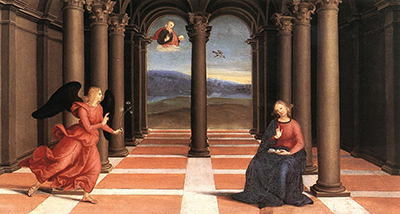One of the 16th century's greatest renaissance painters was Raphael Sanzio. He was a painter credited with producing a number of religious works. One of Raphael’s early works is The Annunciation which is on display in the Vatican Pinacoteca.
Between 1502 and 1504, Raphael painted the artwork we know as The Annunciation. The painting was a commission from the Oddi family. The picture, which measures 27cm x 50cm, involves the use of Tempera on panel. It is a religious painting and one of Raphael’s early works. Although initially part of a collection, it's now on display separately in the Vatican.
Looking at the painting what you see is the event where the angel Gabriel informs the Virgin Mary of the coming of Christ (the Annunciation). As the angel approaches her, the Virgin Mary is seen sitting and appears to be reading. The background consists of two open arches that look out onto open land and a clear sky. In the left arch, there is an image of God looking down from the sky. In the right arch, you can see a dove in the sky. The painting's viewpoint means that The Annunciation has a three-dimensional appearance. Because of Raphael’s use of pillars and perspective in the image, critics say that it makes this a striking work of art.
In 1502, the Oddi family commissioned Raphael to paint the altarpiece for the family chapel in Perugia. The Oddi Altarpiece has the title, Coronation of the Virgin. Below the altarpiece is the predella. The predella is a decorated step or platform that the altar stands on.
The predella for the Oddi Altarpiece consists of three paintings that depict scenes from The Life of the Virgin. One of those paintings is The Annunciation. It is the first painting on the left side of the predella. The two other paintings in order are The Adoration of the Magi and Presentation in the Temple. Nearly 300 years after its painting, the altarpiece and predella were taken to Paris. On display in the Musée Napoleon, they stayed there until 1815. Brought back to Italy, they went on show in the Vatican Pinacoteca and not the Oddi family chapel.
One of the earliest influences on Raphael's work came from the painter, Pietro Vannunci also known as Perugino. As assistant and apprentice to Perugino, he developed his distinctive style of painting. It was during his apprenticeship that he painted a number of religious works including ‘The Annunciation’. It’s said that Raphael learnt the techniques of his master, Perugino so well that it was difficult to distinguish between the two. Raphael’s portrayal of the Annunciation is a common theme that appears in Christian art during the Renaissance period. Many of works produced for the Roman Catholic Church feature the Virgin Mary and the angel Gabriel. During the Renaissance era, nearly all of the great masters produced works that involved the Annunciation.




